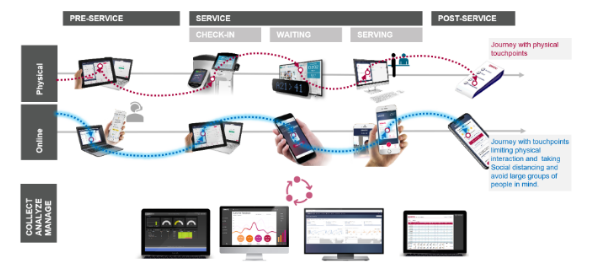Social Distancing Queuing Solutions
The current situation regarding COVID-19 has required us all to take precautionary measures and practice social distancing to reduce the risk of infection. For businesses, this poses a few challenges. Some services must remain available to accommodate the needs of customers. At the same time, the highest priority is to protect your customers and staff from the virus spread, whilst also making sure that you can continue to deliver required services with more dynamic staff availability than usual.
In times like these, it’s important for hospitals, government agencies, and business to adapt swiftly to deal with this situation. How can you continue to provide a service, but minimize the risk for customers and staff? Here are a few virtual queuing tips to help you can achieve this.

Social distancing in waiting area: Limit the number of people visiting your premises
- Minimizing the crowd is the first step towards enforcing social distancing in the waiting area to reduce the risk of infection. This can be achieved through adopting any or all of the following approaches:
Move to virtual queuing
- This allows customers the flexibility to wait in other less crowded locations, for example outside or in their car, therefore reducing the number of people in your waiting room. An advanced virtual queuing system is a solution that can be considered.
Switch to an appointment-only policy
- With appointment booking, customers can schedule their arrival close to their appointment time, which can considerably reduce their waiting time, and prevent crowding your waiting room. This will also reduce or even eliminate walk-ins and unscheduled crowds.
Use a concierge as an alternative for self-check in kiosk or reception
- At the entrance, you can assign a staff member to act as a concierge who can check in customers, book appointments, and take phone numbers to issue paperless tickets by SMS or mobile ticket. This way, customers don’t have to be in the waiting room to check in, and can wait somewhere else until their appointment time.
Keep close interactions/touch points to a minimum
- Whenever possible, replace physical interactions and touchpoints with digital solutions. Here are some touch points that can be easily moved to digital alternatives:
- Booking: Provide online appointment booking on your website, or alternatively, open a call center where a designated staff member can book appointments for customers. Make sure you enable all possible options to do things virtually.
- Check-in: To help with virtual check-in, you can issue QR codes that customers can scan to get into the virtual queue, either online, or at the distance from the premise (on the door or window, for example) to minimize close interactions.
- Waiting: Tying in with the previous section, virtual queue will allow your customers to keep close interactions to a minimum by allowing them to wait somewhere else outside your lobby or waiting area. Use customer notifications to keep them informed while waiting somewhere else.
Manage customer flow and staff allocation
- One of the advantages of implementing a booking-only policy is the ability to manage customer flow. As you can decide how many slots of appointment you will have available, this gives you control of the number of visitors on premise at any one time. With this, you can also allocate your staff based on their availability and the customer demands.
-
Monitoring is a crucial part when implementing virtual queuing, as it can be hard to get an idea of the number of people waiting to get served with just a glance in the waiting room. But with intelligence tools like an operations panel, this can easily be resolved. The operation panel provides data like the number of customers waiting in line, open counters, and staff availability, all of which are useful for resource allocation.
Provide clear communication for both your customers and staff
- To ensure a seamless customer experience, it’s important that customers receive information before, during, and after their visit. Even when they’re not on premise, use email and/or SMS notifications to keep them updated with booking confirmations, reminders, expected waiting times, or any changes. You can also provide information on what to expect on your site (for example, if you check temperature at the entrance, or if your staff wear masks for protection).
-
Similarly, providing information to your staff can lessen stress for them. Communicate events and changes throughout the day so they can be as prepared as possible.